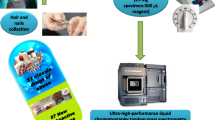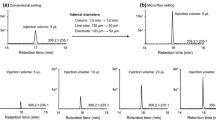Abstract
Purpose
In this study, the usefulness of nail samples instead of hair for a general unknown screening (GUS) for drugs was tested. An alternative matrix for long term detection is still needed in cases where no hair is available for analysis.
Methods
Hair and nail samples from 70 postmortem cases were analyzed by liquid-chromatography quadrupole time-of-flight mass spectrometry. Hair and nail samples were ground by a ball mill and extracted twice for 18 h. Extracts were measured in Auto MS/MS mode (data dependent mode acquisition).
Results
Only 10 % of the cases showed a disagreement of results in hair and nail analysis where hair samples were tested positive and corresponding nail samples were tested negative in a general unknown screening for drugs. In most of the cases investigated the analysis of the nail clippings and whole nail samples led to results comparable to those obtained from hair analysis. The incorporation of a large number of substances into the nail matrix was proven by the detection of 89 different analytes (e.g. antidepressants, drugs of abuse or antihypertonics) in our tests.
Conclusion
In cases where the amount of hair available is not sufficient for a general unknown screening for drugs, nails appear to be a useful comparable matrix for the detection of long-term drug consumption due to the comparison of the qualitative GUS results from the hair and nail samples in this study.


Similar content being viewed by others
References
Pragst F, Balikova MA. State of the art in hair analysis for detection of drug and alcohol abuse. Clin Chim Acta. 2006;370:17–49.
Kintz P, Villain M, Cirimele V. Hair analysis for drug detection. Ther Drug Monit. 2006;28:442–6.
Kintz P. Value of hair analysis in postmortem toxicology. Forensic Sci Int. 2004;142:127–34.
Hastedt M, Bossers L, Krumbiegel F, Herre S, Hartwig S. Fatty acid ethyl esters in hair as alcohol markers: estimating a reliable cut-off point by evaluation of 1,057 autopsy cases. Forensic Sci Med Pathol. 2013;9:184–93.
Hastedt M, Krumbiegel F, Gapert R, Tsokos M, Hartwig S. Fatty acid ethyl esters (FAEEs) as markers for alcohol in meconium: method validation and implementation of a screening program for prenatal drug exposure. Forensic Sci Med Pathol. 2013;9:287–95.
Skopp G, Potsch L. A case report on drug screening of nail clippings to detect prenatal drug exposure. Ther Drug Monit. 1997;19:386–9.
Pounds CA, Pearson EF, Turner TD. Arsenic in fingernails. J Forensic Sci Soc. 1979;19:165–73.
Wilhelm M, Hafner D, Lombeck I, Ohnesorge FK. Monitoring of cadmium, copper, lead and zinc status in young children using toenails: comparison with scalp hair. Sci Total Environ. 1991;103:199–207.
Suzuki O, Hattori H, Asano M. Nails as useful materials for detection of methamphetamine or amphetamine abuse. Forensic Sci Int. 1984;24:9–16.
Valente-Campos S, Yonamine M, de Moraes Moreau RL, Silva OA. Validation of a method to detect cocaine and its metabolites in nails by gas chromatography-mass spectrometry. Forensic Sci Int. 2006;159:218–22.
Garside D, Ropero-Miller JD, Goldberger BA, Hamilton WF, Maples WR. Identification of cocaine analytes in fingernail and toenail specimens. J Forensic Sci. 1998;43:974–9.
Lemos NP, Anderson RA, Robertson JR. Nail analysis for drugs of abuse: extraction and determination of cannabis in fingernails by RIA and GC-MS. J Anal Toxicol. 1999;23:147–52.
Cirimele V, Kintz P, Mangin P. Detection of amphetamines in fingernails: an alternative to hair analysis. Arch Toxicol. 1995;70:68–9.
Engelhart DA, Lavins ES, Sutheimer CA. Detection of drugs of abuse in nails. J Anal Toxicol. 1998;22:314–8.
Ropero-Miller JD, Goldberger BA, Cone EJ, Joseph RE Jr. The disposition of cocaine and opiate analytes in hair and fingernails of humans following cocaine and codeine administration. J Anal Toxicol. 2000;24:496–508.
Engelhart DA, Jenkins AJ. Detection of cocaine analytes and opiates in nails from postmortem cases. J Anal Toxicol. 2002;26:489–92.
Lemos NP, Anderson RA, Robertson JR. The analysis of methadone in nail clippings from patients in a methadone-maintenance program. J Anal Toxicol. 2000;24:656–60.
Garside D. Drugs of abuse in nails. In: Jenkins AJ, editor. Forensic science and medicine: drug testing in alternate biological specimens. Totowa: Humana Press; 2008. p. 43–63.
Madry MMSA, Binz TM, Baumgartner MR, Kraemer T. Systematic investigation of the incorporation mechanisms of zolpidem in fingernails. Drug Test Anal. 2014;6(6):533–41.
Broecker S, Pragst F, Bakdash A, Herre S, Tsokos M. Combined use of liquid chromatography-hybrid quadrupole time-of-flight mass spectrometry (LC-QTOF-MS) and high performance liquid chromatography with photodiode array detector (HPLC-DAD) in systematic toxicological analysis. Forensic Sci Int. 2011;212:215–26.
Guale F, Shahreza S, Walterscheid JP, Chen HH, Arndt C, Kelly AT, Mozayani A. Validation of LC-TOF-MS screening for drugs, metabolites, and collateral compounds in forensic toxicology specimens. J Anal Toxicol. 2013;37:17–24.
Johnson RD, Botch SR. The screening of forensic blood, urine, and tissue specimens for xenobiotics using ion-trap liquid chromatography-tandem mass spectrometry. J Anal Toxicol. 2011;35:65–74.
Maurer HH. Current role of liquid chromatography-mass spectrometry in clinical and forensic toxicology. Anal Bioanal Chem. 2007;388:1315–25.
Saint-Marcoux F, Sauvage FL, Marquet P. Current role of LC-MS in therapeutic drug monitoring. Anal Bioanal Chem. 2007;388:1327–49.
Broecker S, Herre S, Pragst F. General unknown screening in hair by liquid chromatography-hybrid quadrupole time-of-flight mass spectrometry (LC-QTOF-MS). Forensic Sci Int. 2012;218:68–81.
Hang C, Ping X, Min S. Long-term follow-up analysis of zolpidem in fingernails after a single oral dose. Anal Bioanal Chem. 2013;405:7281–9.
Broecker S, Herre S, Wust B, Zweigenbaum J, Pragst F. Development and practical application of a library of CID accurate mass spectra of more than 2,500 toxic compounds for systematic toxicological analysis by LC-QTOF-MS with data-dependent acquisition. Anal Bioanal Chem. 2011;400:101–17.
Acknowledgments
The authors would like to thank Janna Frombach for her technical support.
Author information
Authors and Affiliations
Corresponding author
Rights and permissions
About this article
Cite this article
Krumbiegel, F., Hastedt, M. & Tsokos, M. Nails are a potential alternative matrix to hair for drug analysis in general unknown screenings by liquid-chromatography quadrupole time-of-flight mass spectrometry. Forensic Sci Med Pathol 10, 496–503 (2014). https://doi.org/10.1007/s12024-014-9588-x
Accepted:
Published:
Issue Date:
DOI: https://doi.org/10.1007/s12024-014-9588-x




